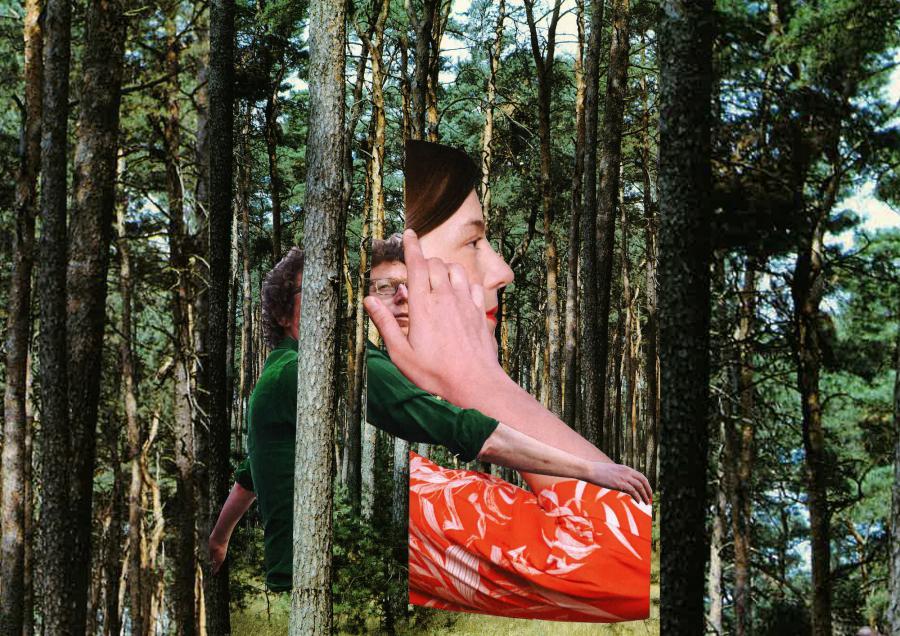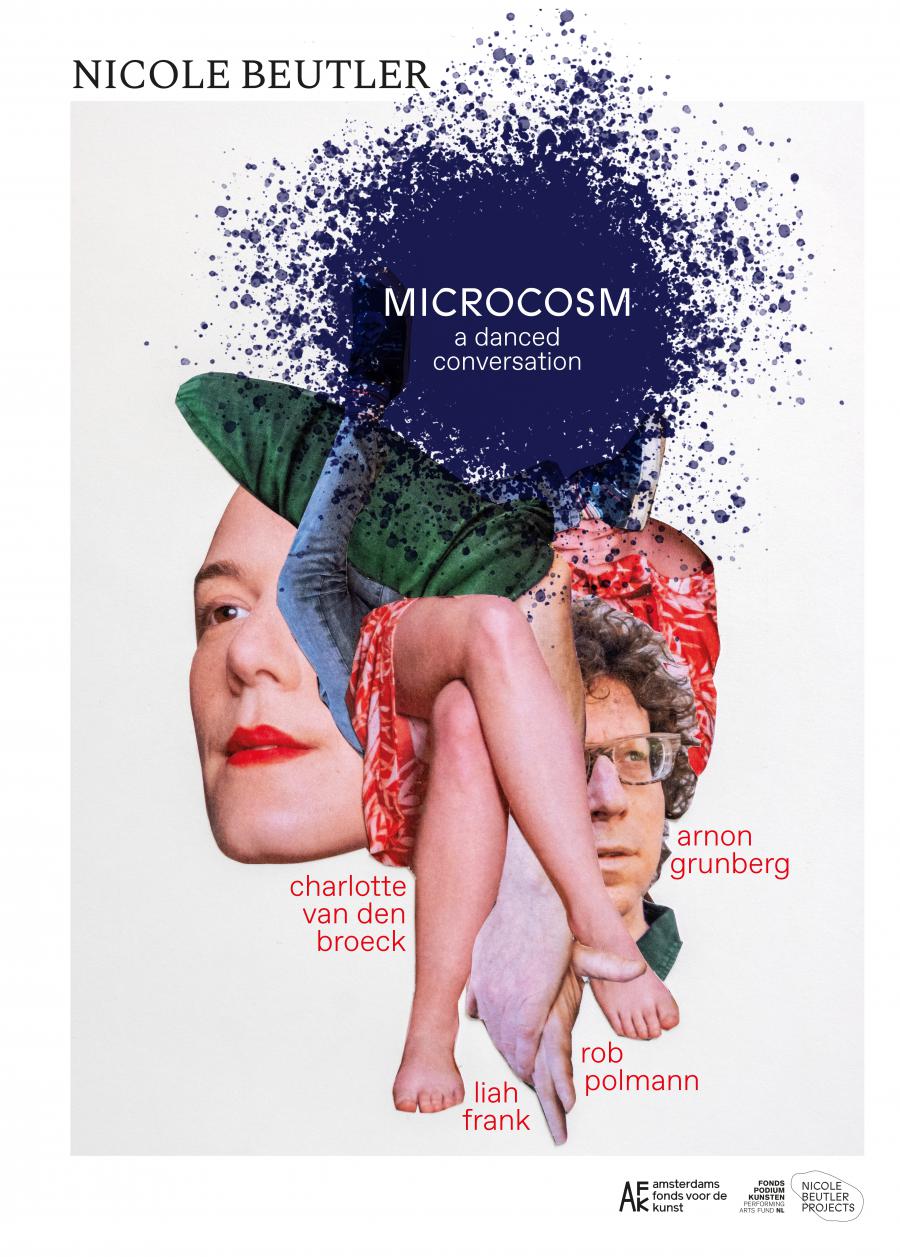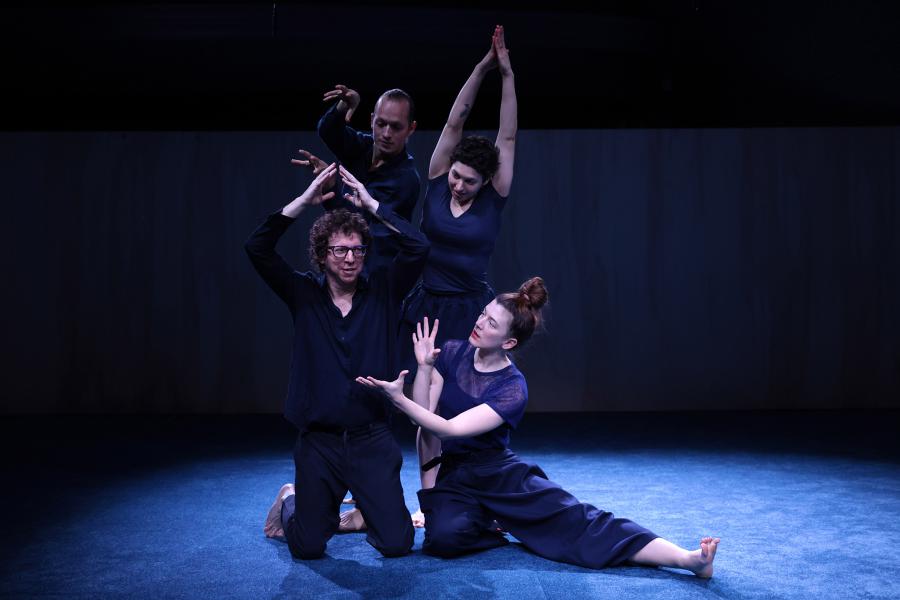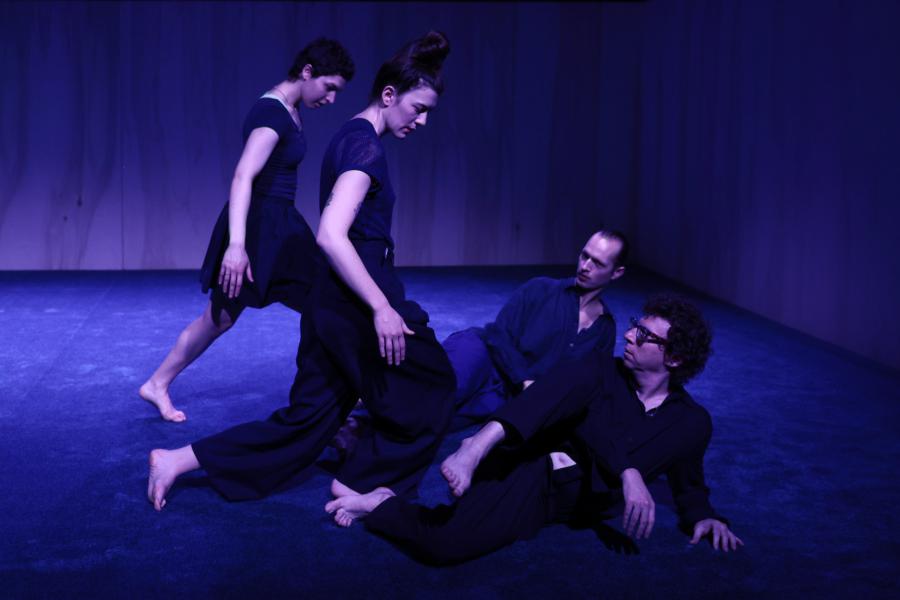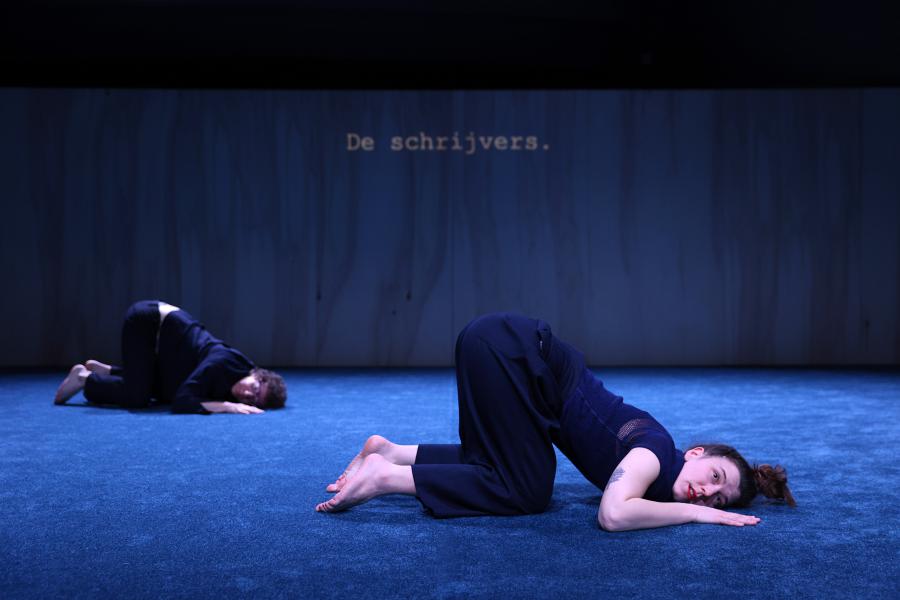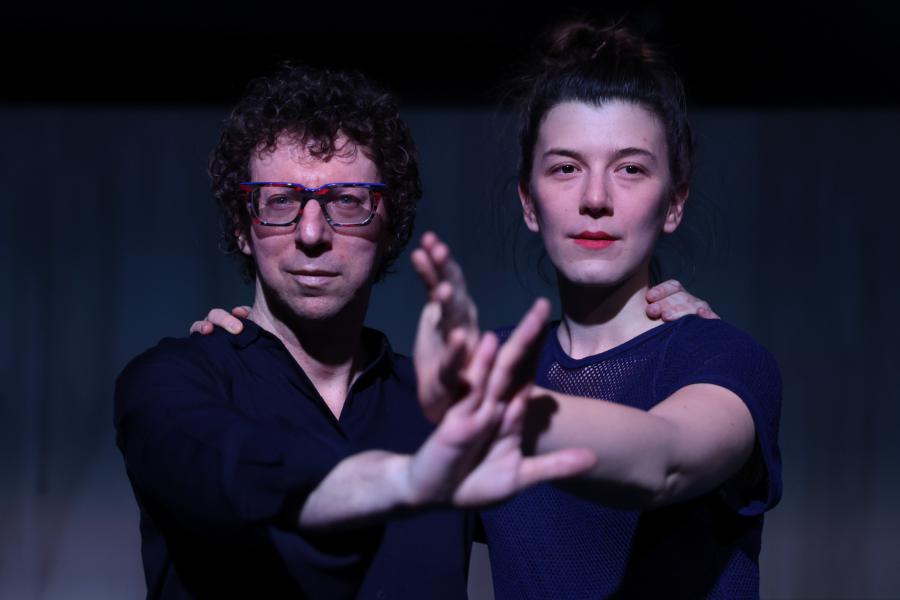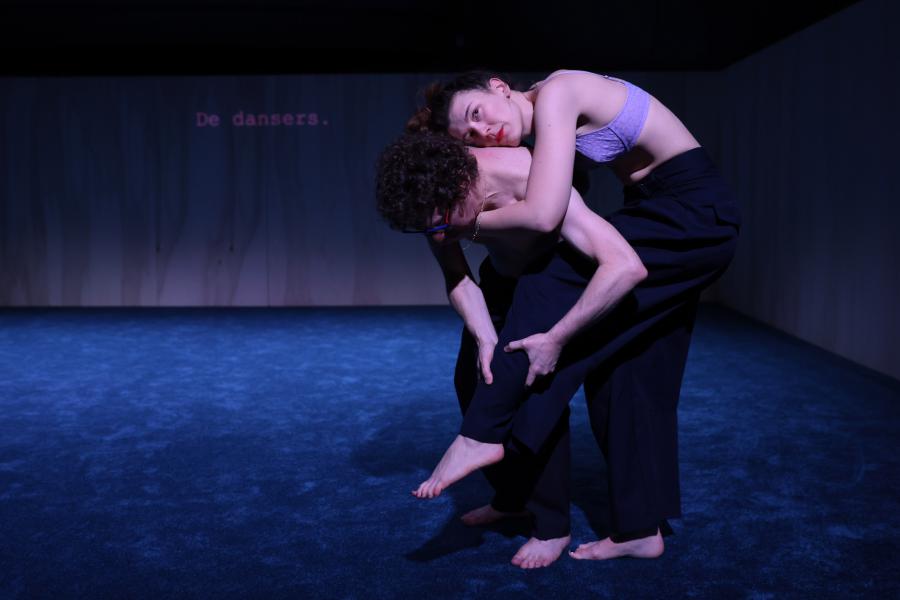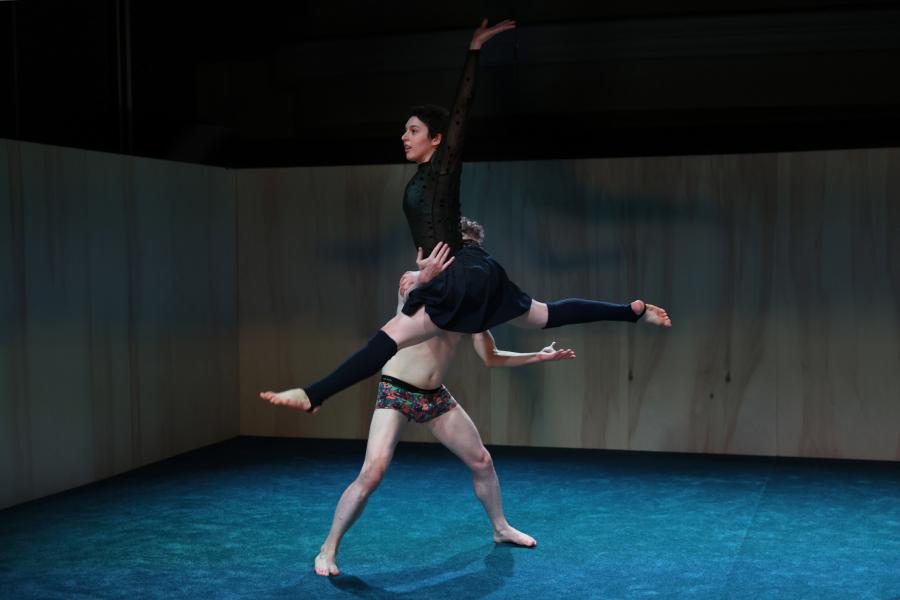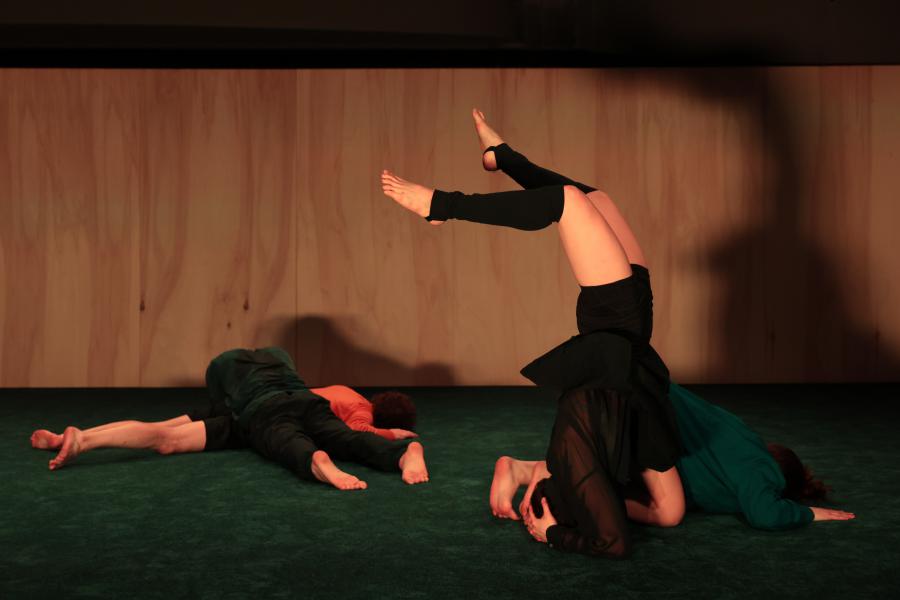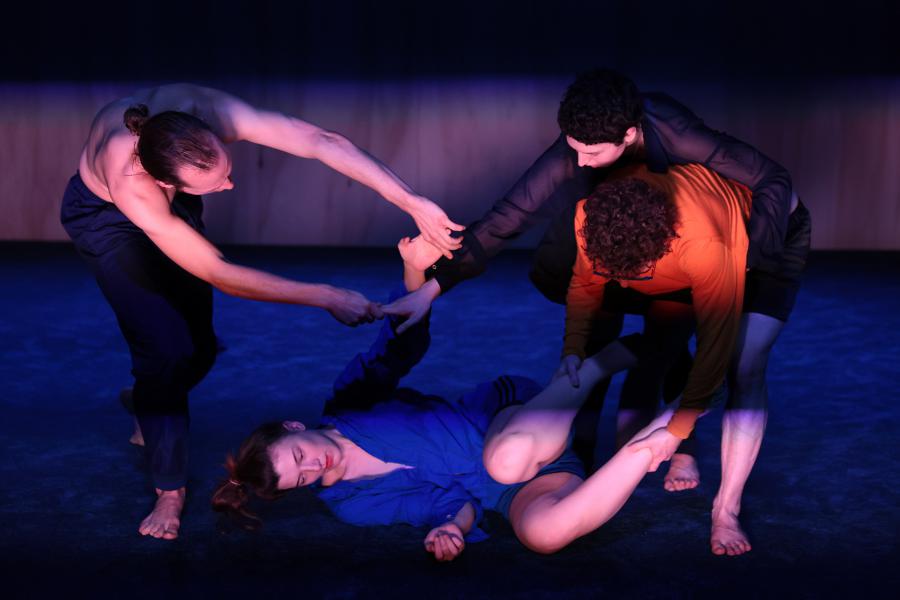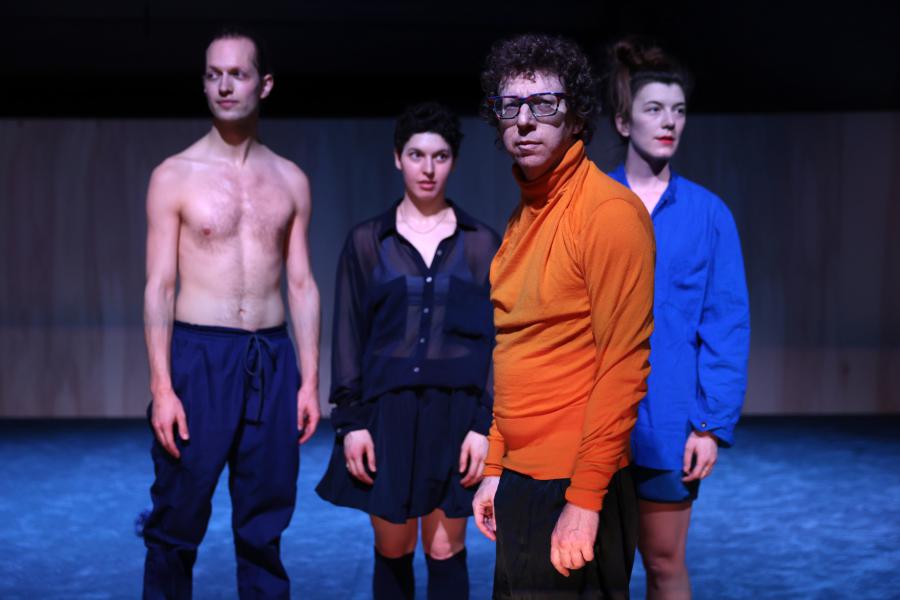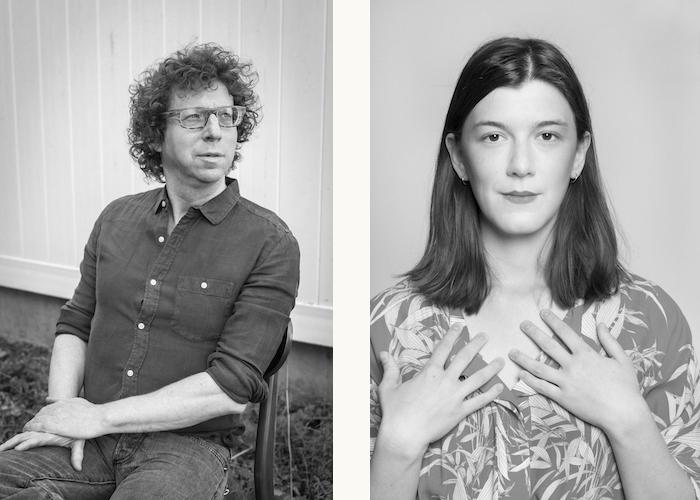microcosm
Two well-known writers confront their shame. Flemish poet Charlotte Van den Broeck and Dutch author Arnon Grunberg quickly agreed: dancing is the most embarrassing thing there is. Reason enough for the long-time pen pals to step out of their comfort zone and create a dance performance together. With microcosm being the result. Visual choreographer Nicole Beutler takes the pair on a journey of discovery through the body. From a nerve-racking dance debut to a liberating conversation between head and body.
Ever since Eve tasted the forbidden fruit in paradise, our consciousness has been inextricably linked to shame for our bodies. But isn't this opposition between body and mind an ancient misconception? Our consciousness has become alienated from the deep wisdom of the body. Through monologues intérieurs, the writers engage in conversation with their own physical discomfort. Dance step by dance step they step out of the overheated head, and into the microcosm of the body. Words and judgments slowly make way for the uncertain healing powers of the material, the corporeal and the sensual.
Arnon and Charlotte are helped in this process by two dancers as auric bodies, guardian angels and challengers, as paragons of balance who confidently wallow in the field of vision of the outside world. What happens there in those perfect bodies? Inside, thousands of processes, millions of cells, microbes and bacteria go about their business while outside, the body folds flawlessly into an arabesque. Our bodies are a symbiotic whole, one cannot exist without the other. A quest to transcend yourself in the light of a boundless universe.
REVIEWS
-
Office Tigers
I wanted to excel in failure', writes Arnon Grunberg about the plan that he and the Flemish poet Charlotte Van den Broeck came up with in their public correspondence. They wanted to do something to overcome their shame. And performing as a dancer was the scariest thing they could think of. For writers, professionally focused on the agility of their minds, the body is often no more than a vehicle that keeps the head, fingers and laptop connected for as long as possible. 'At the height of my neck, the many bending forwards are beginning to take shape', notes Van den Broeck in the run-up to their dance performance called microcosm. But for a spectacular failure, the duo came to the wrong place with the requested choreographer. Nicole Beutler gave the two office tigers each a trained dancer as a second. And what unfolds between the foursome is a sparkling, sensory narrative about freedom, the joy of dance and the celebration of physical differences.
Within a theatrical microcosm, defined by light and set designer Theun Mosk with soft carpet and a light wooden wall, the four performers explore their own and each other's physical possibilities. In step-by-step episodes, underscored by changes in the magical lighting and in the embracing soundscape of Beutler's regular composer Gary Shepherd. First there is standing in space, then the exploration of walking, after which the arms join in. In group scenes, they take turns posing amused as the star of the show, admiring each other's mini solos. There are danced phrases in which the skilled Liah Frank and Rob Polman, as the writers' shadows, lengthen and magnify their smaller movements, a breathtaking doubling where the writer's intention and the dancer's performance reinforce each other. The writers name the basic elements of the performance, which appear in typed letters on the back wall. 'Thank you for coming,' Grunberg says to the audience at the chapter 'audience'. 'Has the storm started yet? Has the war already begun? Van den Broeck is lifted to a microphone high above the stage as she lists the activities of a writer. Touching are the dancer's hands that take the writer's bodies in forgetting their clumsiness. The dancers lead the way in showing their bare torsos, followed by the writers, the wooden fence taking on the pale hue of the fragile flesh; it becomes a skin that surrounds them.
In alternating duets, all careful movements are given the same importance. And all of a sudden all the distinction disappears when the four performers form one organism of rotating bodies that briefly wipes away the storms and wars in the outside world. During the free dancing at the end, Grunberg imagines himself completely shameless as a ballet dancer at a barre. It is a demonstration of a 'carefree state that hardly happens to me when writing' that he discovered during rehearsals, as can be read in the diary columns that he and Van den Broeck kept on the Nicole Beutler Projects site. A victory of the mind over the body, and of the body over the mind.
-
No gloating with dancing writers
At the entrance of the attic room in Theater Bellevue in Amsterdam, Arnon Grunberg, Charlotte Van den Broeck and their two fellow dancers Liah Frank and Rob Polmann nod a friendly hello to the audience. With their warm welcome, they immediately make clear that we should not expect a sacred dance performance, but a human encounter between two writers who venture far out of their comfort zone here.
However, the idea was their own. After Grunberg and Van den Broeck opened the Frankfurt Book Fair together in 2016, they wrote each other a weekly letter in this newspaper. Fear and shame were recurring themes. So the plan was born to do the most embarrassing thing they could think of: dance in front of an audience. They found a patient and generous conductor in the Dutch choreographer Nicole Beutler, so they wrote in the series of columns in which they reported on their adventure for two weeks.
Microcosm – a danced conversation opens with the four dancers in blue costumes on a blue carpet, surrounded by wooden walls. Starting from their toes, they explore the entire space, with a movement quality as fluid as water. The falling drops in Gary Shepherd's ear-pleasing electronic soundtrack make us feel like we are in an underwater world. The dancers swarm around each other, half improvising. In addition, they always just don't touch each other, as in a game of Doctor Bibber.
Van den Broeck – with the hair in a bun, nails painted red and two tree tattoos on the arm – is clearly more agile and has a greater body awareness than Grunberg, who compensates for this with his roguish look and uninhibitedness. He briefly plays a game of tennis with an invisible racket and ball. It is one of the rare concrete moments in the otherwise abstract choreography, in which the foursome embodies the microcosm in our bodies – from single-celled beings to symbiotic organisms (depicted with entangled limbs).
After fifteen minutes the language comes in. Grunberg says aloud that he suspects that some spectators hope for gloating with the dancing writers (that's not that bad: they worked hard and there is a liberating energy in their imperfection). Van den Broeck describes what it does to her, usually still, writer's body to dance. “All cells fill with air.”
Every now and then you can still see the movement assignments and some scenes could have been developed further, but as a whole Microcosm is an enjoyable dance performance. It's over after less than an hour, but the joy of dancing is infectious.
Read the original (Dutch) article here: https://www.standaard.be/cnt/dmf20220223_98101657
-
Dance for readers
On stage during 'Microcosm', a poet and a writer look their ultimate sense of shame straight in the eye: dancing in front of an audience. Together with two professional dancers, they fearlessly expose their bodies. In the run-up, the two wrote a column series about the creative process - a generous contribution to the archives of contemporary stage dance.
27 FEBRUARY 2022
Upon entering the Paloni Hall of Theater Bellevue in Amsterdam, poet Charlotte Van den Broeck and writer Arnon Grunberg are standing on either side of the entrance door to welcome each of us, spectators, with friendly eye contact. Behind them dancers Liah Frank and Rob Polman are getting ready. They already provided support during the work process of 'Microcosm' and soon also on stage.In the weeks before the premiere, the two writers took turns reporting this creation process in twelve episodes, in the newspaper De Standaard and on the website of choreographer Nicole Beutler. Their lyrics provide a wonderful insight by two language virtuoso non-dancers into the mores of the niche field that contemporary dance still is for many. They talked about unwavering discipline, about parking their urge to control and ego, about fatigue, but also about the emotion of close physical contact. A gem of an archival document for an ephemeral art form. We learn from their report that the two writers have performed together before in a literary context. That they wanted to go even further out of their comfort zone, towards ultimate shame. What kind of activity would cause them the most acute discomfort? So dancing, on a stage. They contacted Nederlands Danstheater, who referred them to choreographer Nicole Beutler. After all, she had experience with non-professional dancers.
This season we already saw an actress who dances – Jolente De Keersmaeker at the request of choreographer Jérôme Bel in 'Dance for actress' by tg Stan. Furthermore, the young Benjamin Abel Meirhaeghe, who literally put dancing singers naked on the Madrigals of Monteverdi next to equally naked professional dancers. Bel's focus was on the personal memory of dance: an excerpt from a ballet lesson, a re-enactment from Café Müller by Pina Bausch and Butoh dancer Kazuo Ohno, linked to memories of the actress's father. Meirhaeghe was all about love, drawn out in timeless rituals around open fire and with magical powers in a moving scenic evocation of a cave.
Here in 'Microcosm', the focus is on looking, that's how I saw it. Looking at others as an incentive to look differently at bodies, at your own body. This is how the performance begins: the performers look at us, we look at them. Looking is an intimate matter in 'Microcosm'. The small tribune of the Bellevue Theater accentuates that proximity. Three walls of bare pine around the stage floor do the same. We go for natural, that decision also tells me, while I associate the blue of the floor with communication. Not any blue, no, royal blue because everyone on and around that floor counts for the full amount. Again: that's how I read it. Even the costumes are different shades of blue. At least, until the writer and the poet together gradually become more naked and only their underwear remains.
That this intimacy is not obvious to everyone is immediately highlighted in the first scene. On stage we see Grunberg on the left back to back behind Liah Frank, she facing the audience, he facing the back wall. He doesn't reveal himself yet. On the right Charlotte Van den Broeck looks back to back against Rob Polmann with a magisterial madonna mask straight into the audience.
On the soundscape we hear sounds like drops that the dancers convert into movement. So together we cautiously trickle into the performance, with the writers still watching carefully how the dancers are doing. That doesn't last long. A little later, it is the dancers who follow the movement of the writers with a second's delay. By the end of the performance, they will form a tangle of four organically moving bodies. Before that, together they go through all the constellations (solos, duets, trios and quartets) and degrees of dance technical ability.
The movement material, the writers stated in their texts, was created on the basis of a proven method in contemporary dance: improvisations that the choreographer then fine-tunes and records. Nicole Beutler created a clearly evolving performance from it. She also decided early on in the process that the two writers would not be alone on the stage. Uninteresting, was her verdict, so she placed two seasoned dancers next to them. Absolutely right, because within the set-up of "Microcosm," that choice deepens our view of what a body in motion or at rest can mean.
Because ultimately, in "Microcosm," you're not looking so much at dance phrases or where exactly they take place in space and the passage of time. Rather, it's about: what story do I read in each of their gazes, in each of their bodies as they move there very closely together in front of us. And: how do I relate to this, where exactly am I being touched?
Somewhere around three quarters into the performance, the performers reinforce this approach by briefly walking into the stands to make physical contact with the spectators. Watching here is a game of attuning to and touching each other, literally and figuratively: they hook their eyes into each other, touch us with their watching and movement conversations, we touch them in our shared space. Gary Shepherd's soundscape joins in, with echoes of breath and a heartbeat.
Together they move. The pieces of text that the writers bring to the performance are an extension of how they position their bodies on stage. Clever how Grunberg integrates Russia's military invasion of Ukraine the previous night, into his story. That we spectators nevertheless come and watch - who are you really, he then wonders? Pacifists who won't point a gun at him, and vice versa he doesn't think so either, that much is certain. But a friend of his knows: that audience of yours is 'just like people' just waiting for you to fall.
That worldview characterizes his body language: we see Grunberg's resistance to surrender; he prefers confrontations with a knee and a playful headbutt; in skipping steps or with a swipe; full of swagger to ironically keep the possible failure of his somewhat wooden writing body at bay. Next to him, Lijah Frank is perfectly cast with her cheerful, outgoing no-nonsense energy. She dares to be just as uncontrolled in her movements as he is hyper-controlled, to the point of physical cramping with the short steps of a professionally seated body. It's nice how Grunberg's theorems eventually fail. In the penultimate scene he is the only one who deviates from the blue tones by pulling an orange shirt over his head, while the lighting also glows orange as in a reference to the global fire, you see his dueling self melting away in a final duet with Polmann, when he slowly strokes his limbs with loving attention. The writer already said it in one of his texts: Polmann's look could convert him to gentlemen's love.
Charlotte Van den Broeck, for her part, was not inferior to Liah Frank and Rob Polmann in terms of presence. A real dancer was lost to her through poetry. It is in her gaze, the balance she finds between inside and outside. She tastes movement. From her body speaks the kind of focus and inner silence that she might also use for her poetry. In her text on stage, she talks about that writing process, the tricks with which she tames the words and her escape reflex. Her language to the audience is inviting, she juxtaposes her own experiences as an spectator, talks about the breath that connects us, and how we can let it descend deep into our pelvic floor. I see her writing from her toes. Next to her, Rob Polmann is equally hushed, soft and indulgent.
'Microcosm' transcends the gauntlet recorded on a blue Monday. We get to unashamedly read the intelligent bodies of two dancing language virtuosos with 'real' dancers as benchmark. A party.
Read the original (Dutch) review here: https://www.pzazz.theater/nl/recensies/dans/dans-voor-lezers
-
WRITERS PLAYFULLY DANCE THEIR SENTENCES ON THE FLOOR
Almost imperceptibly, the back wall fades from blue to creamy white. The soft, springy carpet in front of the dancers remains blue. It looks comforting and offers shelter. Apart from the soundtrack by DJ Gary Shepherd, the dance space arouses great silence.
Designer Theun Mosk must have been inspired by the two writers who dance in Microcosm, a danced conversation: Arnon Grunberg and Charlotte Van den Broeck. It is as if the danced space is their writing place. This idea is confirmed by the entrance of the two author-dancers. They enter the space unaccustomed, look around, hesitantly start their movements as if they are writing down the first sentences. Gradually there is momentum and inspiration. Their bodies sway over the floor like dancing pens.
How it began, two authors on the dance stage? Van den Broeck and Grunberg performed together at the 2016 Buchmesse, when the Netherlands and Belgium were "spearheads”. They started a correspondence in which shame and fear were the key words. In response, Van den Broeck suggested that they should start dancing, 'to be seen as a wordless body’. After some searching at, among others, the Nederlands Dans Theater (in vain), they found choreographer Nicole Beutler willing to turn their physical voyage of discovery into theater.
Beutler made a great find for Microcosm. She thought that she should give the two authors an experienced dancer as accompanist, in the persons of Liah Frank and Rob Polmann. This produces beautiful harmonies and contrasts. The experienced dancers are a shadow of the unaccustomed, untrained, debutant mock dancers.
And so, for an hour, the quartet enters into a joyful and intimate relationship with each other. Not that Grunberg (50) and Van den Broeck (30) are just doing somethin, on the contrary. Beutler has practiced with them for a long time, Van den Broeck has a powerful presence and Grunberg has something special about him, as if he keeps an eye on his partners and does or imitates what they do. That works well.
The physical language of dance seems far removed from written or spoken language. But that is appearances. Actually, on that soft plush of the dance floor, the dancing writers do the same thing: their movements are like sentences, sometimes long, then short, angular or fluid. They trust each other completely and collectively build beautiful sculptures. They run and lie still on the floor, making the leg split (Grunberg!) or support each other's feet on the other's (Van den Broeck!).
It's exciting when Grunberg catches an almost horizontal, forward leap from Frank with arm and even chin. And then suddenly there is talk. Did something go wrong? Did he miss? Grunberg does a fine game of aerial tennis, and in another scene he clings to the wall, as if on a barre. There he does his exercises, with a cheeky, disarming look into the room, like: 'Look at me.' Van den Broeck, also because of her professional outfit, looks quite advanced. There is also an interesting play with the costumes, by Jessica Helbach. The dancers start dressed in blue, gradually perform naked and end in a more colorful design.
Perfection is of course often the goal in dance. The body in full light is viewed, from the dark, through countless eyes. Here, perfection is not so much the primary goal, but rather the path to it. You recognize primary dance exercises, such as keeping balance and making turns. That makes Microcosm recognizable and playful.
In the end, something goes wrong, or so it seems. The dancers seek contact with the audience, as if they want to invite a single spectator to come on stage as well. But that does not happen, so that something indefinable lingers. That's a shame, now the performance lacks a clear marking at the end.
Read the original (Dutch) article here: https://www.theaterkrant.nl/recensie/microcosm-a-danced-conversation/nicole-beutler-projects/
-
Microcosm, with Arnon Grunberg and Charlotte Van den Broeck, is a lighthearted quartet that is becoming ever closer, freer and more intimate
A man-sized, wooden fence around a soothing blue carpet suggests a sheltered spot for the four performers who expose themselves quite a bit during Microcosm. But of course we watch as the Dutch writer Arnon Grunberg (50) and the Flemish poet Charlotte Van den Broeck (30) feel the soft plush with their toes and try to speak the physical language of dance with half-naked bodies. In columns and interviews they have expressed how, with this debut, they are looking for their greatest shame: dancing in front of an audience. Choreographer Nicole Beutler picks up the gauntlet and gives them two conversational dancers as support: Liah Frank and Rob Polmann. They take the writers with them as cheerful stowaways in a light-footed quartet that becomes increasingly close, free and intimate.
Logically, compared to the professionally developed body awareness of the dancers, that of the writers stands out as untrained. The younger Van den Broeck looks strong and athletic when she allows herself to be partnered and lifted. The smaller Grunberg, with glasses and necklace, sometimes looks like a cheeky jester, especially when he imitates he imitates fierce tennis strokes with tongue between lips or smiles as he skips over the soft floor with his hips turned out and legs raised high. Yet Microcosm never becomes a caricature or parody of dancing-with-non-dancers (which happens more often). You feel their energy released in this victory over their fear. And it is touching to see how caring bodies react to each other in self-directed, yet uncomfortable situations of physical contact. However, the confrontation with the spectator deserves further elaboration. Now this is only a short final chord in an otherwise carefully constructed and attentively performed performance. After all, in being watched is the real game with the pain.
Read the original (Dutch) article here >>
-
"Beutler pushes the boundaries of this microcosm"
Two writers who want to overcome their embarrassment for dancing in public are given a soft landing in Microcosm, thanks to the dedication of two professional dancers. And the audience finds it entertaining, too.
In recent days, much has been written about the dance debut of P.C.Hooft prize winner Arnon Grunberg and the acclaimed Flemish poet Charlotte Van den Broeck. Especially about their motivation. In their weekly correspondence in the newspaper De Standaard, the authors concluded that dancing was the most shameful thing they could think of.
Open mind
To combat that shame with an open mind, they approached dance maker Nicole Beutler. In Microcosm, Beutler found a form that elevates the project above the level of public therapy. She sends the non-dancers onto the floor with two professional dancers. At first, Rob Pollman and Liah Frank pose as patient facilitators. Toward the end, the structures become more complex, making the contribution of the non-dancers as essential as that of the pros.It is clear from the start that Van den Broeck – slim, straight build, twenty years younger than Grunberg – has more to offer as a dancer. Seriously and with palpable concentration, she throws herself into the movement material that is offered to her. . Grunberg does not lack dedication either, yet he follows a different strategy. In a column he wrote at the beginning of the rehearsal process, he set himself the goal of mastering the split. “If the split doesn't work, there's always the comedy, the fluttering human.” Well, that split didn't work. And so Grunberg, who simply keeps his glasses on when dancing, lets the comic side shine through. This threatens to turn clownish in a solo in which he mows down his surroundings like a madman with an invisible tennis racket.
Barren weather
Supported by a light-hearted composition by Beutler's regular composer Gary Shepherd, the four performers grow towards each other in an organic group process. Beutler pushes the boundaries of this microcosm by also naming the role of the public. Grunberg praises the visitors who came to the theater despite harsh weather conditions. Van den Broeck immediately puts the audience back in its place: it is therefore the intention that spectators keep their mouths shut. The reflections on the theatrical situation are not very profound, but excite just enough to engage the viewer.The professional dancers, especially Frank, add an extra layer with their personalities, in the way they seek a connection. With large dark eyes, the Israeli dancer continues to explore Grunberg and Van den Broeck. Curious about what goes on in the minds and bodies of the writers. Hungry, as a trained dancer, to learn something from these non-dancers.
NEWS & CONTEXT
Cast & Credits
Language: Dutch & English
Concept & direction: Nicole Beutler
Music: Gary Shepherd
Dance & text: Arnon Grunberg, Charlotte Van den Broeck, Rob Polmann, Liah Frank
Dramaturgy: Igor Dobricic
Costume: Jessica Helbach
Scenography & lighting design: Theun Mosk
Technique: Martin Kaffarnik, Prem Scholte Albers
Production: Nicole Beutler Projects
Coproduction: Bellevue Lunchtheater
With many thanks to: Goethe-Institut Amsterdam, Likeminds, Hillary Blake Firestone, Keren Levi | Neverlike, Albena Georgieva
With the support of: Fonds Podiumkunsten, Amsterdams Fonds voor de Kunst
Acquisition & international tour planning: Jimmy-Pierre de Graaf

